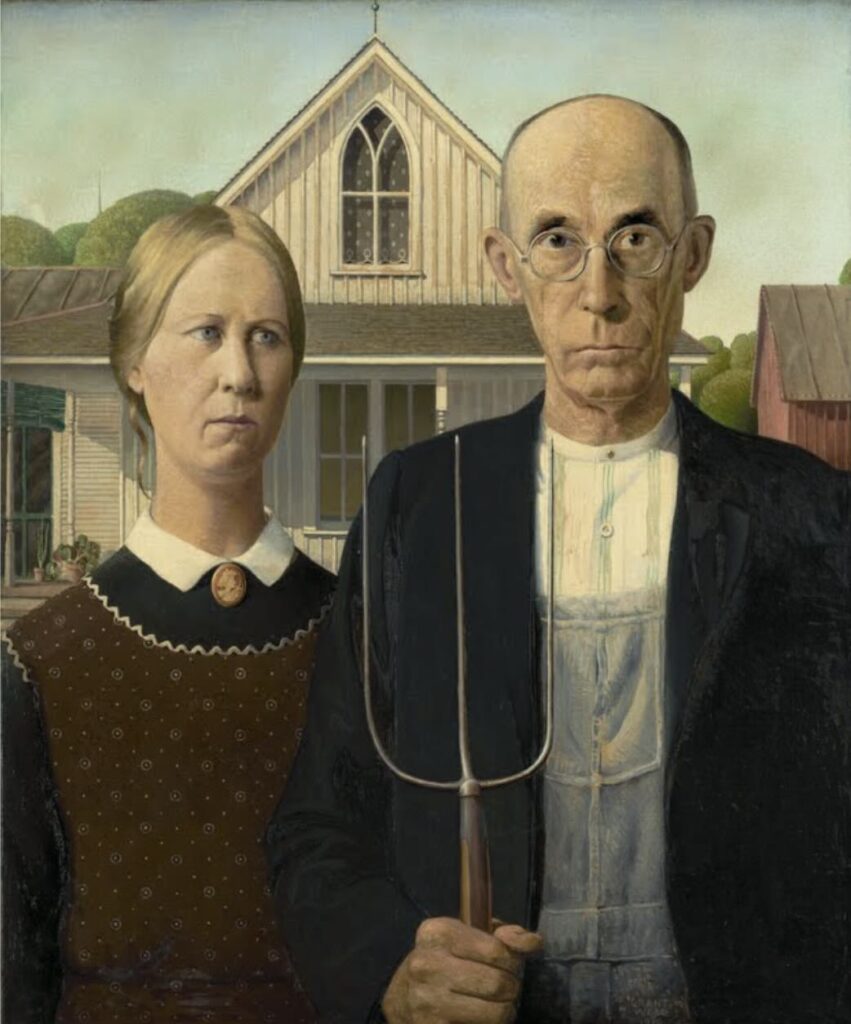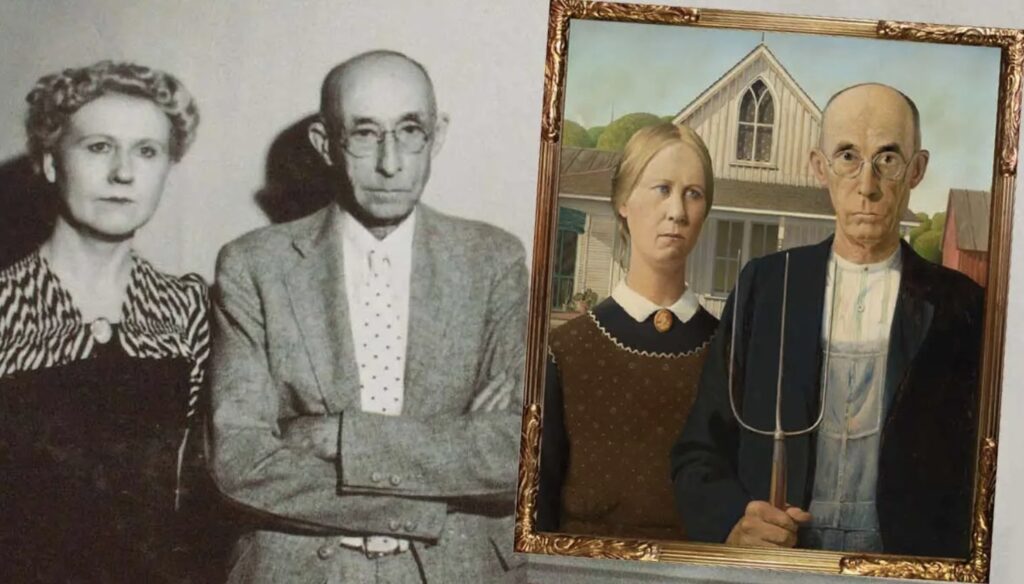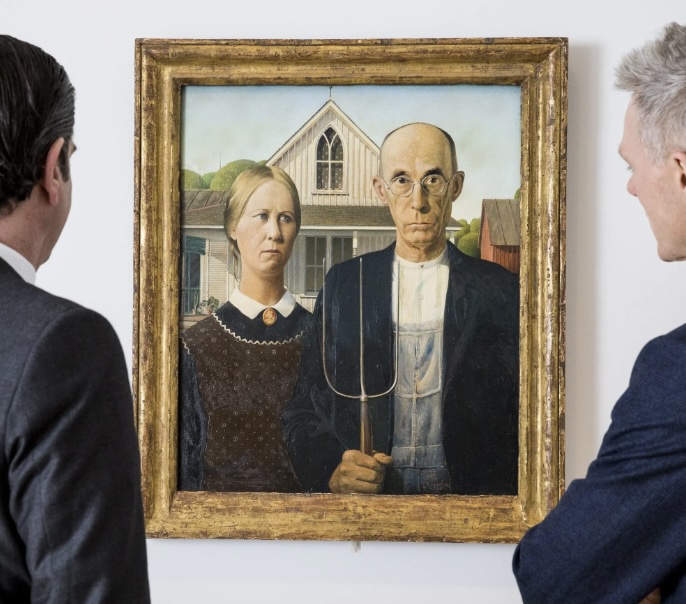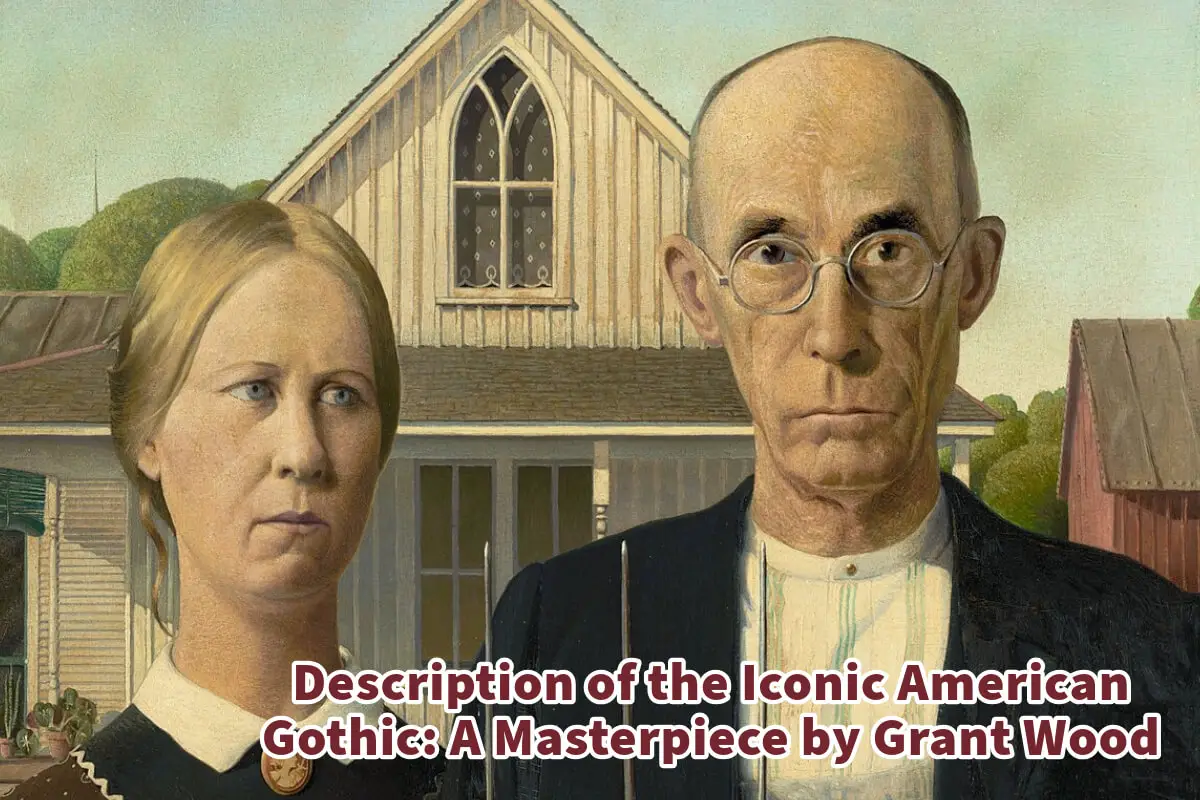One of the most iconic paintings is Grant Wood’s America Gothic. For many, it is the ultimate American work of art.
American Gothic, painted by Grant Wood in 1930, is one of the most recognizable and parodied artworks in American culture. This masterpiece is not just a depiction; it’s a narrative woven with traditional values, sharp detailing, and profound symbolism, encapsulating the essence of rural America during the early 20th century.
Table of Contents
- Exploring the Timeless Allure of American Gothic: Grant Wood’s Iconic Masterpiece
- Ten Reasons Why American Gothic Remains an Iconic American Painting
- Enduring Symbolism:
- Relatability:
- Archetypal Imagery:
- Artistic Precision:
- Pop Culture Reference:
- Versatility in Interpretation:
- Educational Tool:
- National Pride:
- Aesthetic Appeal:
- Global Recognition:
- Listen To Our Podcast About What Makes Grant Wood’s American Gothic So Iconic?Below or By clicking here.
- Related Questions
Exploring the Timeless Allure of American Gothic: Grant Wood’s Iconic Masterpiece
American Gothic, created by Grant Wood in 1930, is heralded as one of American art’s most iconic and frequently parodied pieces. This masterpiece transcends mere artistic depiction, presenting a narrative rich with traditional values, meticulous detailing, and deep symbolism that captures the quintessence of rural America in the early 20th century.

The painting features a stern-looking couple, often misidentified as farmers but representing a rural dentist and his daughter standing before a white house distinguished by a striking Gothic window.
This setting in Eldon, Iowa, with its Carpenter Gothic architecture, underscores the painting’s thematic focus on steadfastness and resilience, reflecting the national character during the challenging times of the Great Depression.
Grant Wood’s choice of subjects, dressed in traditional garb against the backdrop of a modest yet architecturally intriguing home, invites viewers into a world where simplicity and complexity coexist.
The figures’ attire and the home’s decorative window convey a historical narrative, intertwining personal identities with broader cultural values. Wood’s technique—precise, almost photographic in its clarity—enhances the viewer’s engagement with the scene, bringing a sense of immediacy and realism that has kept the painting relevant for nearly a century.
In its composition, American Gothic is a study in contrasts: the straightforward expressions of the subjects juxtaposed against the intricate stylings of their environment, illustrating the complexity of American life and identity during an era of economic and social upheaval.
Description and Explanation of the Painting
American Gothic features a stern-looking couple standing in front of a white house, characterized by a distinctive Gothic window. The man, often mistaken for a farmer, represents a rural dentist, holding a pitchfork and dressed in overalls beneath a black jacket.
Beside him stands a woman, interpreted as his daughter, wearing a colonial print apron mimicking 19th-century Americana. The backdrop of their house in Eldon, Iowa, with its Carpenter Gothic style, adds an architectural interest that complements the figures’ rigidity, symbolizing the steadfast American spirit.

The Unique Choices Behind American Gothic: Father-Daughter Pairing and a Rural Dentist
Grant Wood’s American Gothic is renowned for its visual composition and the intriguing choices behind its character representations. Contrary to popular belief and initial impressions, the figures in the painting are not a farmer and his wife but a father and his daughter.
This decision by Wood to portray a father-daughter duo rather than a marital couple adds a layer of complexity and innocence to the narrative, diverging from the typical depiction of rural American life in the 1930s.
By choosing this familial relationship, Wood emphasizes themes of heritage and continuity, reflecting a deep-rooted, generational passage of values and traditions central to the American Midwest ethos.
Furthermore, the male figure in the painting is often misidentified as a farmer due to his pitchfork and overalls, elements quintessentially associated with farming. However, Grant Wood intended this character to be a rural dentist, a profession that signifies a blend of intellectualism and practicality.
This choice underlines Wood’s nuanced approach to characterizing rural Americans, who are not just agricultural laborers but diverse, multifaceted individuals contributing to different aspects of community and economic life.
The pitchfork, held firmly by the dentist, symbolizes labor and toil, attributes that resonate with the broader American work ethic across various professions, not limited to farming. By depicting a dentist in this rural setting, Wood challenges and expands the viewer’s perception of rural American identities, adding an unexpected but profound dimension to the iconic image.

Historical Context and Inspiration For American Gothic Painting
Grant Wood, an Iowa native, was inspired to paint American Gothic during a visit to Eldon, Iowa when he stumbled upon a small white house with a singular Gothic window. Intrigued by the contrast between the house’s modest scale and the window’s grandeur, Wood imagined the kind of people who might live in such a dwelling.
A part of him found it quite absurd that such a small house in such a small town would have this kind of window. That is the house that inspired his iconic painting.
More than just a window, the entire home and the painting were conceptualized as a tribute to the steadfastness and resilience he perceived in the rural American people during the Great Depression. It reflects a deep appreciation for the traditional values that Wood saw as underpinning the national character.
Technique and Materials of American Gothic Painting
Wood’s technique in American Gothic is meticulous, with a high level of detail that lends a near-photographic quality to the work. He painted it in oil on Beaver Board, a commonly used material, which allowed for fine, precise brushwork.
Wood’s style in this painting is characterized by its clean lines and smooth finish. It reflects the influence of Northern Renaissance art, which he admired for its precision and attention to detail. The palette is subdued, utilizing somber colors that enhance the overall seriousness and perhaps the moral narrative of the painting.
Ten Reasons Why American Gothic Remains an Iconic American Painting
Perhaps no other painting shows American life and represents rural America and Grant Wood’s American Gothic. Here are 10 reasons why American Gothic continues to be an iconic American painting.

Enduring Symbolism:
The painting captures the essence of the American spirit—hardworking, resilient, and rooted in traditional values—qualities that resonate with many even today.
Relatability:
The depiction of ordinary Americans has made the painting relatable to a wide audience and embedded it deeply in the national consciousness.
Archetypal Imagery:
The figures have become archetypes of the Midwesterner, embodying the American experience during the Great Depression, adding a historical and cultural depth that continues to intrigue audiences.
Artistic Precision:
Wood’s meticulous technique and the influence of Northern Renaissance art elevate the painting from a simple portrait to a masterful artistic creation.
Pop Culture Reference:
American Gothic has been widely parodied and referenced in various media, including movies, television, and advertising, cementing its place in American pop culture.
Versatility in Interpretation:
The painting invites multiple interpretations, from a straightforward portrayal of rural life to a complex, symbolic representation of American values, sparking continual discussion and study.
Educational Tool:
It serves as an educational tool in discussions about American art, culture, and history, particularly the 1930s and the impact of the Great Depression.
National Pride:
The painting is often viewed as a symbol of national pride, reflecting the enduring American spirit and the country’s cultural heritage.
Aesthetic Appeal:
Despite its simplicity, the painting has a unique aesthetic appeal with its distinctive Gothic element and detailed portrayal, attracting art lovers and critics alike.
Global Recognition:
American Gothic is recognized globally as a quintessential piece of American art, enhancing its status and popularity beyond the United States.
Through these elements, Grant Wood’s American Gothic continues to hold its place as a cornerstone of American art, offering insights into the era in which it was created and the enduring American identity. This painting remains a profound narrative of resilience, rendered timeless by its craftsmanship and the universality of its themes.
Listen To Our Podcast About
What Makes Grant Wood’s American Gothic So Iconic?
Below or By clicking here.

Anita Louise Art is dedicated to art education, great artists, and inspiring others to find and create their art. We love art that uplifts and inspires. #ArtToMakeYouSmile! #ArtToMakeYouHappy!
If you are interested to see any of my art, you can find out more by clicking here. If you are interested in what inspires me and my paintings, you can discover more by clicking here.
We have a free newsletter and would love you to be part of our community; you can subscribe to the newsletter by clicking here. If you have any questions, I would be happy to talk to you any time. You can reach me, Anita, by clicking here.
Subscribe to our Anita Louise Art YouTube Channel filled with great videos and information by clicking here.
Related Questions
The American Regionalism Style, Grant Wood & The American Gothic Painting
The American Regionalism art style was a movement that was popular during the American Great Depression. The movement was about painting a realistic picture of America’s rural countryside, most notable in the midwestern United States. One of the most iconic paintings for that style was Grant Wood’s American Gothic painting.
By clicking here, you can learn more by reading The American Regionalism Style, Grant Wood & The American Gothic Painting.
Why The Painting American Gothic Is Called That?
The American Gothic painting is named after the gothic-style windows Grant Wood found on a small house in Eldon, Iowa. To him, these gothic-style windows seemed out of place for such a small house in a rural setting; gothic windows were usually reserved for churches.
By clicking here, you can learn more by reading Why The Painting American Gothic Is Called That?
17 Facts About the American Gothic Painting by Grant Wood
Grant Wood’s painting, the American Gothic, has a Carpenter Gothic Style house with a stoic man with a pitchfork and women staring off to the side painted outside their house. The American Gothic painting has a lot of ambiguity associated with it, which has lead to speculation about its true meaning; all this ambiguity has raised the painting’s profile over the years. The painting received a 3rd place finish in an art competition at the Art Institute of Chicago.
By clicking here, you can learn more by reading 17 Facts About the American Gothic Painting by Grant Wood.

